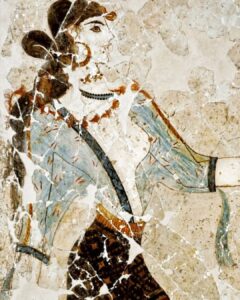Introduction to the Artwork
The Adorants Fresco is part of a beautiful wall painting discovered in Akrotiri on the island of Santorini, dating back to the 17th century BC. This fresco is one of many in the Minoan style, preserved almost intact by volcanic ash from the Thera eruption.
Artistic Characteristics and Style
The Adorants Fresco exemplifies the unique painting style of the Aegean civilization, featuring vibrant colors, stylized forms, and distinctive poses. The figures in the painting appear in ceremonial stances, possibly participating in rituals or making offerings. This piece highlights the artistic advancement of the Minoan and Cycladic people, where human form and expression were portrayed with great sophistication.

Symbolic Meaning Analysis
Archaeologists and art historians have developed various theories about the symbolism of the figures in the Adorants Fresco. They suggest that the reverent postures, with raised hands, represent respect and prayer within religious ceremonies. This reflects the complex belief system of the Minoans, where rituals played a significant role. The fresco also mirrors the close connection between people, nature, and the deities in their beliefs.
Historical Context and Archaeological Value
The Adorants Fresco is part of the artistic heritage unearthed from the ancient city of Akrotiri, which once thrived as a bustling trade center before being buried under volcanic ash. The discovery and preservation of this fresco provide scientists with a deeper understanding of the social life and beliefs of the Minoans during the Bronze Age. It also allows comparisons with other civilizations, such as ancient Egypt and Mesopotamia.

Conclusion
The Adorants Fresco is not only a work of aesthetic value but also a valuable source of historical, cultural, and religious insight into the Minoan people. Through it, we gain a greater appreciation for the diversity and development of ancient Mediterranean civilizations and the importance of preserving and studying such cultural heritages.
